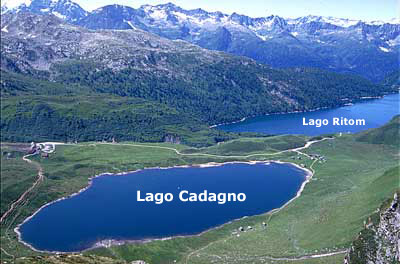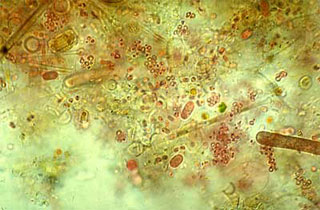 |
|
|
|
|
|
|
Lago di Cadagno is a well studied lake in the south of Switzerland. It's a textbook example of a meromictic lake. These lakes lack complete circulation during spring and fall. The geochemistry of the catchment basin reveals sulfate containing rocks. Weathering processes transport significant amounts of sulfate into lake Cadagno. As you will see in this section, sulfur and light are key players in this lake ecosystem and we will focus on sulfur cycling mechanisms used by indigenous organisms. |
1 - Lago di Cadagno |
|
Stable stratification Lake Cadagno shows a stable stratification all over the year. Neither wind nor water
inflow disturbs these strata. As a result, the hypolimnion gets anaerobic. The catchment basin of lake
Cadagno consists of bedrock containing sulfate.
|
|
2 - Stratification in lake Cadagno |
a underwater spring
|
|
Underwater springs (a) feed substantial amounts of leached sulfate into the hypolimnion of
lake Cadagno. This sulfate rich, heavier water rests at the bottom of the lake and prevents mixing during spring and fall. |
|
3 - Underwater spring |
4 - Anaerobic bacteria |
5 - Chromatium spp. |
|
Night |
6 - Conditions at night |
Light supply governs bacterial behavior in lake Cadagno. During the night, purple bacteria are no longer capable to oxidize hydrogen sulfide to sulfate. The hydrogen sulfide containing layer increases and the purple bacteria move upwards. The next day, the detoxifiers take up their work once more. The hydrogen sulfide sinks again. |
|
Winter The darkness phase lasts much longer in winter, when the lake lies under an ice and snow cover (i). The basic living conditions are withdrawn from the bacterium stratum during several months. The organisms die gradually and both the algae (h) and the purple bacteria (d) strata thin out. The room for the oxygen dependant organisms gets narrower and narrower. |
|
7 - Winter conditions |
a underwater spring
|
29 August 2011 |
||
| |
||




